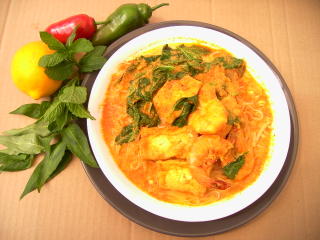 Lemak laksa with prawns and fried tow foo.
Lemak laksa with prawns and fried tow foo.
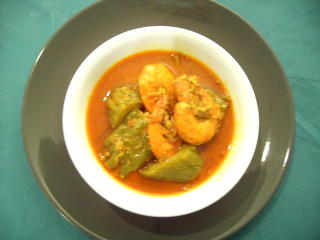 Bitter gourd and prawns lemak
Bitter gourd and prawns lemak.
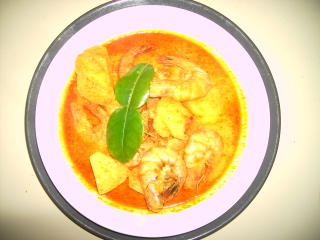 Pineapple and prawns lemak
Pineapple and prawns lemak.
THE BABAS AND NONYAS.
The Babas and Nonyas or the
Peranakans are a unique class of people. Stories are told of Chinese sailors going to Malacca to trade in the 17th century.
These Chinese went with out their families and women. Some of the men became homesick and married the local Malay women and so the
Peranakans were born.
The males are called
Babas and the females, the
Nonyas. Their descendants spoke Malay with Chinese thrown in and Chinese with a bit of Malay thrown in, in their sweet sing song lingo.
The nonyas dress like the Malays,but with their ‘sarongs and beautiful hand sewn kebayas with diamond brooch(
kerosang)’. The
Peranakans have hand beaded sandals and beautiful long hair pins for their hair buns. (These hair pins were very popular back in china, with the jade and pearls)
In their homes are beautifully decorated alters, red wood furniture and antique porcelain vases.
The Malays do not eat pork, but the Nonyas do, so some their dishes are modified to suit themselves.
Sometimes the
Perankans are referred to as ‘straits born’ those born in the Straits of Malacca. There are
peranakans from Singapore, Penang and Malacca. The cuisine from Penang and Singapore tend to be on the sweet side.
The
peranakans of Malacca are also said to have some Portuguese influence in their cuisine.
I remember going to a grand aunt’s house, there was an old lady, dressed in her
sarong and
kebaya with those jade pearl hair pins, speaking only Malay and chewing the betel leaves.
Her lips were stained red from the juice of the betel leaves. She was toothless; she had a mini pestle and mortar next to her. In this she pounds the betel leaves before chewing it. (So inventive, I thought, I was 7 years old then)
Sometimes things do look confusing to an on looker, because of their cultural traditions of the many local races, one tends to think that the
Peranakans are neither here nor there. Today, they are very proud of their history and cuisines.
Their blend of exotic spices and herbs created this wonderful marriage of an interesting glorious fascinating cuisine. The preparation is time consuming but the reward is real worth while!
Here are some of our favorite dishes. Some are from grand aunts grandmas and friends.
The festive dishes are;
PONTAY (posted earlier) a stew with chicken, pork, mushrooms, bamboo shoot.
DUCK SOUP (itek team)SAMBALS.CHOP CHAI SOUP. (Vegetarian soup with fish balls and a touch of teowcheong.)
THE LEMAKS.
(A dish cooked with coconut cream and lots of herbs, hot and creamy.)
THE ASSAM.
(A dish cooked with lots of herbs and tamarind paste, hot and sour, very appetizing)
Their daily cooking usually has sauce : tempora, this method of cooking is the fish, chicken or eggs are first fried , then sliced onions, chilies are added , fried, and water and black sauce added and let to simmer.
This dish goes well with sambal blachan. In most nonya’s house, this sambal blachan is made fresh every day.
Their finely cut up vegetables stir fry with thinly sliced pork and a touch of teowchoeng. (fermented soy beans)
Their best desserts, the sweet, beautifully done, ‘Nonya kuih’ with coconut cream and rice flour. Some are baked over charcoal fire to give them the real taste of home cooking!
BOBOR CHA CHA , ( a sweet soupy dessert boiled with sweet potatoes and yam in thick coconut cream, flavored with the all important leaves, the pandan leaves, thicken with sago.
To describe their ways of cooking would take a long long time, all I can say is, if you have not tried it, find a friend ( who would have home cooked nonya food , nothing beats the home cooked style)or a nonya restaurant and give your taste buds a real treat!
Here are a few recipes, try it for yourself!.
PINEAPPLE AND PRAWNS LEMAK.
½ kilo prawns, trim the heads.
½ pineapple, cut in wedges.
To pound together.
2 serai,( lemon grass)
½” galangal (langkwas)
½ bowl small onions
5 pips garlic
a piece blachan
10 dried chilies or 4 tablesp. Chilly powder.
1” turmeric (kuyit)
soak 4 slices of the dried assam in ½ bowl of water.
1 teasp. finely cut ginger flower.
With this ‘ rempah’ you can cook many other dishes too.
Fry this in 4 tablesp. Oil over med, heat till the oil is nice and red. Add in pineapples, then the prawns, pour in the assam water.
Add 3 bowls of coconut cream. If you can get fresh santan (coconut milk). Use 3 bowls of the second pressing, add the first pressing last, this is to give it the creamy coconut taste.
This first cream must not over boil, or it will turn oily.
If you use the can coconut cream, 1 can will do.
Salt to taste. A pinch of sugar.
Use this same base for
LEMAK LAKSA.
Add more coconut cream to get more stock for the noodles.
Add Vietnamese mint and mint if you want to serve it as the
LEMAK LAKSA. For this laksa , you can top the rice noodles with shredded chicken, boiled pork, fried tow foo, finely cut ginger flower and cucumbers strips.
Copyright©by gourmetchef,2005.
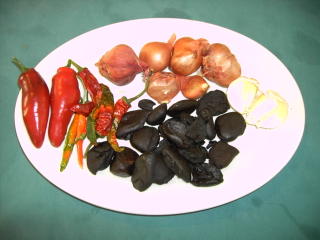 This is the dried Buah Kluwak with out the shell.
This is the dried Buah Kluwak with out the shell.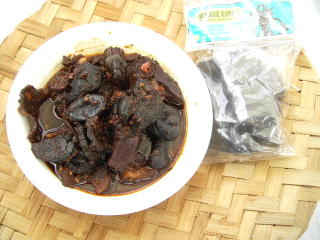 Sambal Buah KLuwak with Pork.
Sambal Buah KLuwak with Pork.


